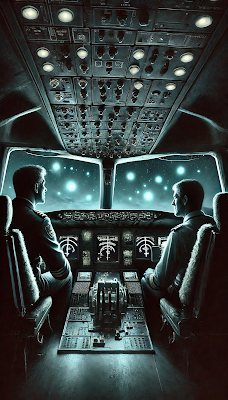Captain Eric Larkin’s voice trembled with a mixture of awe and dread as he recounted the night’s events. The video feed from his cockpit camera flickered with ghostly traces of light that defied conventional understanding. The jet, a massive Boeing 747, soared silently through the vast expanse, its crew alone amidst an emptiness punctuated by stars and the occasional passing cloud.
Eric's co-pilot, Lieutenant Daniel Hayes, adjusted the volume of the intercom, his eyes wide, reflecting the eerie lights dancing beyond the cockpit windows. The jet had taken off from Riyadh, bound for Lagos, beneath an inky-black sky flecked with the distant glow of celestial bodies.
"Look at that, Eric," Daniel whispered, his voice a blend of wonder and trepidation. He pointed toward the viewport where multiple small, luminous orbs drifted aimlessly, their brightness piercing the dark.
Eric gripped the control yoke tighter, his gaze fixed on the mysterious lights. “They’re not showing up on the radar, Dan. We should see them if they’re aircraft.”
Daniel leaned closer to the window, his brow furrowed. “It’s not a light plane either. That would be on our radar. And the stars don’t move like that.”
The orbs glided in erratic patterns, shimmering intensely against the night’s canvas. They pulsed with a rhythm defying natural order. The soft hum of the jet's engines filled the cockpit, punctuated by occasional beeps of instruments, all seemingly irrelevant in the face of the unfolding anomaly.
Eric’s initial dismissal of the lights as mere reflections faded as the orbs continued their unsettling ballet. “It could be drones, but those would have to show up on our systems. And they don’t have lights like these.”
“Satellites?” Daniel suggested, though uncertainty marked his tone. “They don’t move like this, either.”
Eric’s eyes narrowed as the orbs’ movements grew more erratic, drifting apart and then converging with impossible precision. His knuckles whitened on the yoke. “No, I don’t think so. This is… something else.”
The lights’ dance grew increasingly chaotic, mocking the limits of human understanding. They wove through the dark, seeming aware of their audience. A growing chill filled the cockpit, as if the temperature had dropped several degrees. Eric’s breath came out in visible puffs, mingling with the cool, conditioned air of the jet.
#
The video on Captain Larkin’s YouTube channel, titled “UFO Intercept with Boeing 747,” became a haunting testament to their experience. Viewers flooded the comments with skepticism and curiosity.
One commenter, under the pseudonym ‘StellarWatch’, dismissed the sighting with casual familiarity. “As an airline pilot, I see these lights all the time on late-night flights. They usually appear in the same regions of the sky depending on our heading. Nothing new.”
The comment mocked the seriousness of Eric’s account, dismissing the surreal and unsettling phenomenon as mundane. Yet, as Eric and Daniel reviewed the footage, the unsettling realization grew: The lights had not merely been observed; they had been experienced in the intimate space of their aircraft, pushing the boundaries of their understanding and sanity.
#
Weeks later, the Pentagon admitted to seeing similar “metallic orbs” globally, acknowledging their inexplicable maneuvers. Dr. Sean Kirkpatrick, the AARO director, spoke of these phenomena with detached curiosity, offering little solace to those who had faced them up close.
As Eric sat alone in his quiet, dimly lit office, he replayed the footage repeatedly. The lights’ hypnotic dance haunted his dreams and waking moments, filling him with a visceral fear of the unknown. His once-familiar cockpit now felt like a stage for an alien ballet—its purpose and meaning still elusive, leaving only a lingering terror that perhaps the sky held secrets far darker than anyone could imagine.






